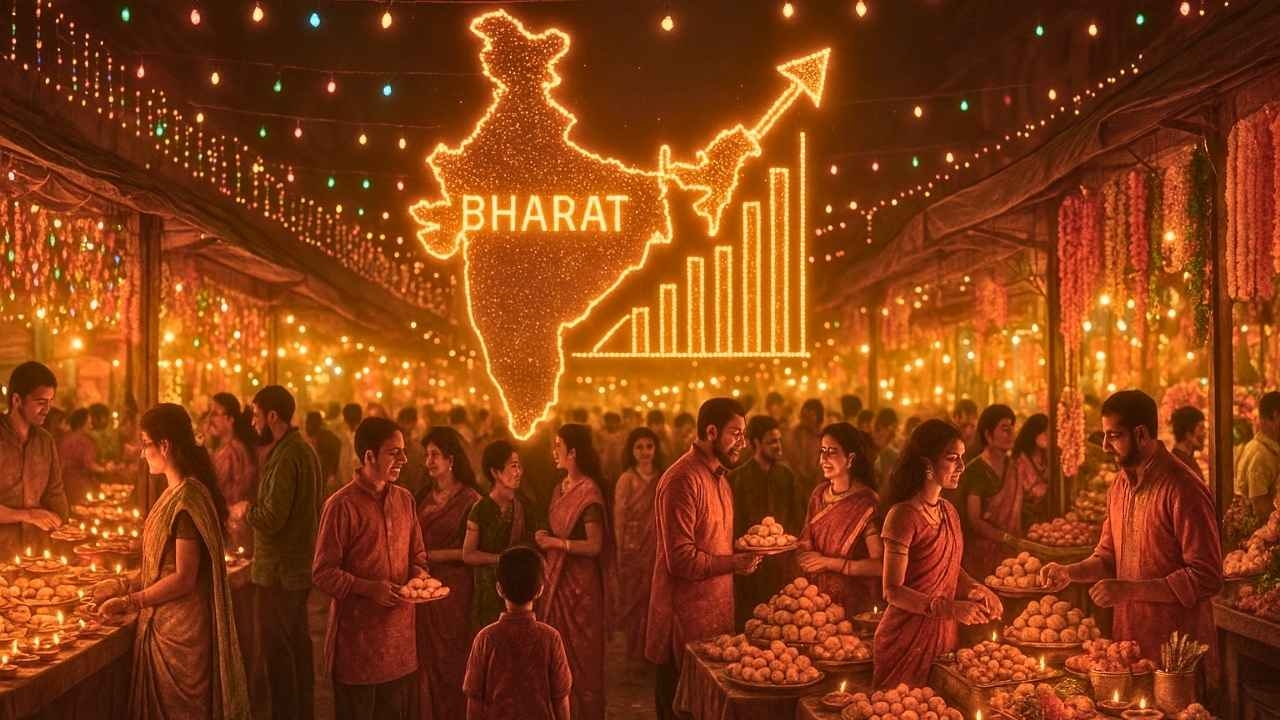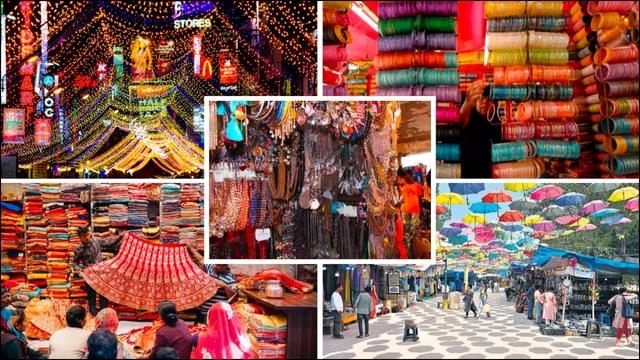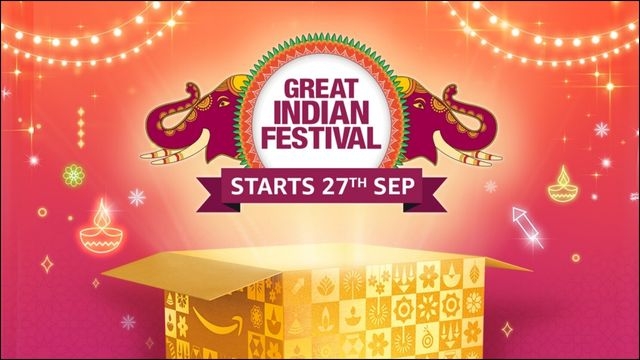Diwali 2025 Lights Up Bharat’s Economy with a Record Festive Boom
Diwali 2025 has not only illuminated homes but also energised Bharat’s economy, creating jobs, boosting retail, and strengthening the vision of Aatmanirbhar Bharat.
Total Views |

Bharat is celebrated for its rich cultural heritage, which spans centuries and includes a vast array of traditions, languages, cuisines, art forms, and philosophies. This immense cultural wealth is vividly expressed in the diverse festivals celebrated throughout the country, each rooted in unique regional practices, religious beliefs, and historical events. And the festival of lights, Diwali, converts this cultural wealth into a magical boost to the economy.
The economic impact of Diwali extends across multiple sectors and drives substantial economic activity annually. The festival creates a ripple effect on various industries, including retail, real estate, tourism, finance, and manufacturing. The lighting up of 24 lakh diyas at Ayodhya at Shri Ram Temple to commemorate the return of Lord Rama is self-explanatory of the economic distribution of wealth taking place this year just at Ayodhya, connecting each man in the supply chain of making and selling diyas, oil, cotton and other related things.
This year’s Diwali celebrations have illuminated more than just homes in Bharat; they have ignited unprecedented economic activity across Bharat, marking a historic milestone in the country’s retail sector. According to a comprehensive nationwide survey conducted by the Confederation of All India Traders (CAIT) and highlighted by the Prime Minister’s Office Research & Trade Development Society, Bharat recorded an extraordinary Rs 5.40 lakh crore in goods and Rs 65,000 crore in services traded during the Diwali 2025 season. This represents the highest festive turnover ever witnessed in Indian retail history.
The survey, which covered 60 major markets and thousands of traders from Tier 1, 2, and 3 cities, validates the impact of visionary leadership under Prime Minister Narendra Modi. The Prime Minister’s persistent advocacy for Swadeshi (self-reliance), Vocal for Local, and rational GST reforms has translated into tangible economic growth and renewed market confidence.

Compared to last year’s Rs 4.25 lakh crore festive sales, the 2025 Diwali trade marked a remarkable 25 per cent increase, a clear indication of stronger consumer sentiment, enhanced purchasing power, and the positive effects of GST rate reductions on key categories such as garments, footwear, confectionery, and home decor.
The data also revealed a significant shift in consumer preference, with 87 per cent of buyers opting for Indian-made goods over imports. Sales of Chinese products experienced a notable decline across cities, while Indian manufacturers enjoyed an average 25 per cent growth in sales compared to 2024. This underscores that the Swadeshi movement has evolved from an emotional appeal into a potent economic driver fuelling the vision of Aatmanirbhar Bharat (self-reliant Bharat).
Retail trade too witnessed an extraordinary boom. The Confederation of All India Traders (CAIT) reported record festive business worth ₹6.05 trillion, a 25% year-on-year increase from 2024. The CAIT report highlights the broader economic impact of this trade boom, with nearly 50 lakh temporary jobs created in sectors such as logistics, packaging, transportation, hospitality, and delivery services. This surge has provided a robust boost to small and medium enterprises (SMEs). Notably, rural and semi-urban Bharat contributed about 28 per cent of total sales, demonstrating truly inclusive and pan-Indian consumption growth.
The Trader Confidence Index also rose to 8.6 from 7.8 last year, while the Consumer Confidence Index increased to 8.4, reflecting widespread optimism about Bharat’s retail economy. These indices affirm the success of government policies aimed at encouraging entrepreneurship, simplifying regulatory compliance, and sustaining consumption beyond the festive season.
According to the National Payments Corporation of India (NPCI), the Unified Payments Interface (UPI) recorded a historic 740 million transactions on Diwali eve, with daily transaction values crossing ₹1 lakh crore on six occasions this October. The month’s total digital payment value is expected to exceed ₹28 lakh crore, the highest ever, reflecting a 13% month-on-month rise driven by festive spending and GST rate cuts.

E-commerce platforms mirrored this trend, with festive sales crossing ₹1.2 lakh crore. Amazon’s Great Indian Festival alone saw over 276 crore visits, while quick commerce platforms like Zepto and Blinkit recorded a 120% rise in orders. Demand for gold coins, electronics, and fashion items soared, particularly in Tier-2 and Tier-3 cities, signaling a deeper digital shift in consumer behavior.
The services and entertainment sectors joined the boom, with restaurants, cinemas, and live events reporting an 8–20% rise in discretionary spending. Travel surged too, as flight bookings rose up to 65%, with Ayodhya witnessing over 100% growth.
Significance of Festivals in ‘Aatmanirbhar Bharat’
Bharat’s festivals play a significant role in supporting the vision of Aatmanirbhar Bharat (Self-Reliant Bharat), a campaign launched by the government to boost the country’s economic independence and resilience by encouraging local production and consumption. Deepawali across Bharat contributes to this vision by driving demand for locally made products, fostering entrepreneurship, supporting artisans, and promoting traditional industries.
The festival creates a strong demand for indigenous products like khadi clothing, handloom fabrics, organic colours, and locally crafted decorations. During Deepawali, there’s a trend toward using traditional items like handmade lamps and cloth decorations. Campaigns advocating “Vocal for Local” promote these products, encouraging people to choose domestically produced goods that support local industry and craftsmanship.
By embracing local products and services during festivals, the people of Bharat actively contribute to a self-reliant economy, helping fulfil the vision of Aatmanirbhar Bharat in a culturally meaningful way. Diwali contributes considerably to Bharat’s economy, offering an annual economic boost and reinforcing consumer sentiment.
The festival’s economic impact reflects both a surge in short-term economic activity and a reinforcement of cultural traditions that influence spending behaviour across diverse sectors.
Article by

Kewali Kabir Jain
Journalism Student, Makhanlal Chaturvedi National University of Journalism and Communication

